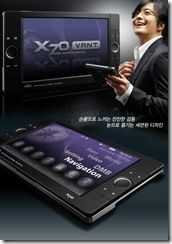This video, taken at the Viliv launch event in Korea, shows some nice detail about the cube user interface on the Viliv S5.
It’s an interesting way to tackle the problems of using a desktop OS with a finger. Of course, when you get past the UI you’re dealing with the same old problems but these sort of layers could make XP more attractive and friendly to MID buyers and yet still give the power users the back-end they require to do productive work.
YouTube user ’59hjh’ has other videos too. The video playback demo shows KMPlayer dealing with a 16mbps 720p file and outputing it to an HD screen with no problems at all. The browser demo shows, as we’ve seen before on the Atom-based devices, a top-notch mobile Web experience.
S7 is still on the roadmap
Expect to see the S5 at CES along with two other Atom-based devices. We’ve been in touch with Yukyung Technologies and they tell us that the S7 will be appearing in working form. The S7 is the very interesting pro-mobile ultra mobile PC we had hands-on with at IDF (see specs and video) and looks like it matches rumoured Sony ultra mobile PC specs.
The S5 is derived from the X5 PMP so it makes sense that there will be an Atom-based variant of the X70 tablet-style PMP shown on the right. There’ll be a working prototype of it at CES codenamed X70-Atom. For a slate 7″er to be well received in the consumer market it’s going to have to have something special so we’re looking forward to seeing what it’s key features are.
It looks like Yulkyung’s ViliV products are going to be ones to watch at CES. The designs and specs look extremely attractive so far and the prices that they talked about at IDF, very competitive. The only thing that remains is to find out about US and EU availability. For what it’s worth, I’ll certainly be encouraging Yukyung to get these devices out into these areas ASAP.












I was wondering if there would be an Atom version of the X70. I can’t wait to see what they show at CES. I like Yukyung’s industrial designs, particularly the S5.
Chippy, quick question, in one of the pics, how come when the screen resolution is at WSVGA, it scales down to 256k color? Are all screens with WSVGA resolution between 3.5″ to 4.8″ 256k color? I have a feeling this is due to a battery consumption issue.
I think the screen’s native resolution is 800 x 480, and it interpolates to 1024 x 600, similar to the HTC shift. Please correct me if I am wrong.
Any thought?
Not sure about the 265K colour issue but I know Viliv are offering this in 800×480 AND 1024×600 versions.
Steve.
Chris you are right, from what I can figure out the native scren is 800×600 and 1024×600 can’t run at full 16-bit color, but you’ll have an option to switch between the two.
Now the battery life is supposed to be real-usage 4-5 hours. One reports say it lasted average 4 hours with:
-Wi-FI/Bluetooth/GPS/DMB on
-Screen at full brightness
-720*480, Divx5/MP3, 30fps, 3-4 Mbps video running
-No low power modes on the GMA 500 GPU
Biggest thing is I think their claims of 200 hour standby time! With such a long standby time it can be used much more like a PMP and a phone. Even if the standby time is fraction of what they claim(say like 50 hours), you can just put the unit on standby and in 2-3 secs the system will be back up.
Now the rumored pricing is $400-600. We’ll see how it goes and probably overseas pricing will be higher. But nothing really achieves such specs and battery life at that price range. Other ones like the upcoming Sony, Fujitsu U820, Kojinsha SX is like 2x the price.
Keyboard is not worth $400 and the biggest thing blocking MIDs/UMPCs from penetrating the market is the price.
All screens with WVGA resolution between 3.5’’ to 4.8’’ are 256k color such as SONY and Wibrain B1. That’s not scaled downed as well as not interpolated. That’s is nature of all the LCD available in the market.